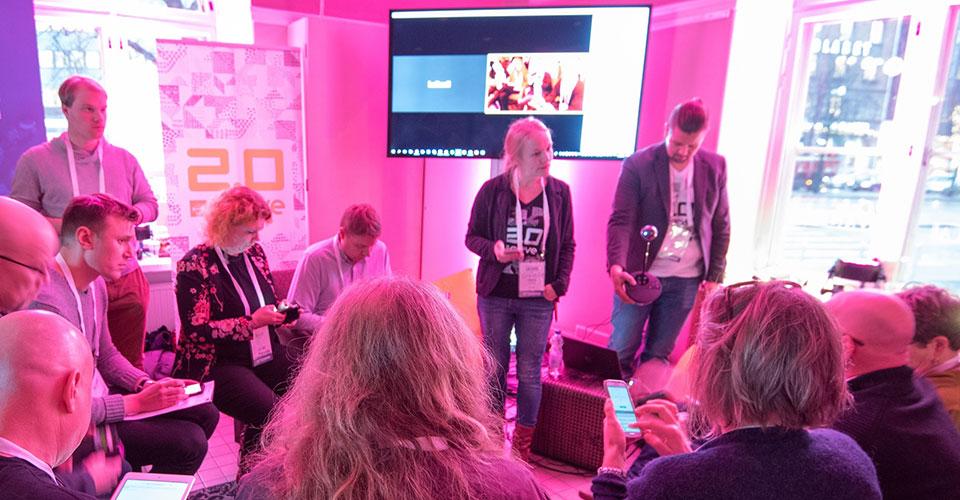
Arja Puustinen, Henry Paananen & Katja Maetoloa
In Finland, creative economy and intangible value creation are one focus area in the innovation policy to increase competitiveness both nationally and globally. A great number of strategies, policies and projects ensure the prerequisites for companies and entrepreneurs to use and develop intangible capital in their businesses. At the same time, there has been a substantial shift and boost towards entrepreneurship-driven economy. This has resulted in rising numbers of start-ups, development projects, entrepreneurial studies and services available for everyone. (Ministry of Education and Culture, 2017, pp. 19–21; Lahtinen et al., 2016, pp. 5, 15–16; Maliranta, Pajarinen, & Rouvinen, 2018, pp. 6, 9–11)
The transformation of work by digitalization increases the need to actively support employees to change and adapt. Digitalization refers not only to technical aspects such as robotics and automation, but also to comprehensive digital skills that enable an effective information handling, active social inclusion and employability. Small and medium-sized enterprises (SME) are caught between the increasing digitalization of the world of work and the expectations placed on them in terms of productivity and innovation. SMEs often lack time as well as resources to strategically deal with digital challenges. Recognizing opportunities that digitalization has for new entrepreneurs in creative industries is essentially important in supporting successful business growth in. The DC4WORK project (DC4WORK, 2019) has created open resources for SMEs to facilitate learning at work. Resources focus on the digital skills and competences and can be utilized widely to support digitalization in SMEs.
In creative industry, digitalization is only one challenge SMEs face. Internationalization, business development as well as need of continuous competence development are additional challenges. Entrepreneurs in creative sectors lack often specific abilities and skills like internationalization, networking, digitalization both in production and delivery, immaterial rights and patent protection, selling, pricing and so forth. The size of the firms often is rather small which creates pressure for networking and finding the right business partners. These barriers complicate the emerging of start-ups and slow down the growth and development. (Creve 2.0, 2018) The Creve 2.0 project is trying to dismantle these obstacles by creating a versatile conformation of services and trainings that support both the creative industries and use of them in Finland. The aim of the project is to create a national service structure for creative industries that has constant collaboration with other industries, business services, educational institutions and other supporting services. (Creve 2.0, 2019; HAMK, 2019)
One work package of the project encompasses the development of a tool for better anticipating and responding to the future potential and success of creative start-ups and business ideas. The evaluation tool is not just a technical one but also contains human and learning factors in it. (Creve 2.0, 2019; HAMK, 2019) In this article, we present iterative processes of the development and the first contents of the evaluation tool.
Creative Ecosystems as a framework
Intangibility has become a key element of the success in terms of improved competitiveness, export activities or higher pay rolls. (Oksanen et al., 2018, pp. 3–5; Ministry of Economic Affairs and Employment, n.d.; Tarjanne et al., 2011, pp. 12–13, 19–20) In Finnish policy making, creativity and economic development have been studied within three conceptual frameworks: creative industries, creative economy and intangible value creation. They form key factors in creative economy ecosystems development in Finland. (Oksanen et al., 2018, p. 4)
Creative industries refer to a sector-focused type and line of businesses and activities (Table 1). The problem has been a lack of a precise definition of the included sectors and fields. On the other hand, instead of precise definitions and in-box-thinking, cross-sectoral collaboration and interaction between actors in an innovation-driven economy has been emphasized as more important than definitions. (Oksanen et al., 2018, p. 6; Tarjanne, 2019, presentation at Creve strategy and development day March 4, 2019)
Table 1. Categorization of creative sectors. (Oksanen, 2018)
| CREATIVE AND CULTURAL PRODUCTS | CREATIVE CONTENT | CREATIVE SERVICES | CREATIVE ENVIRONMENTS AND PLATFORMS |
|---|---|---|---|
| Heritage and Arts | Media | Functional Creations | New Media & Games |
| Crafts | Film (inc. animation) | Advertising and marketing | IT, software and computer services |
| Museums, galleries and libraries | TV, video, radio and photography | Architecture | Creative places/events |
| Festivals | Publishing (inc. music managers) and literature | Design; product, graphic and fashion design | Digital games |
| Music (live + royalts) | AR/VR | ||
| Performing and visual arts |
According to Oksanen et al. (2018, pp. 9–10) creative economy is a concept of various competences in creative industries and works, both within specific sectors and across different sectors. The concept of ecosystem is been used to describe and understand variety and complexity of evolving creative economy. Valkokari (2015, pp. 20–22) presents three ecosystem types that differ in terms of their outcomes, interactions, logic of action and the roles of actors. Knowledge ecosystems are exploring and producing new information, knowledge and future competencies. Innovation ecosystems are boosting commercialization and transforming knowledge into products, services and novel ideas. Business ecosystems have structures and tools to ensuring and building growth. (Valkokari, 2015, p. 22)
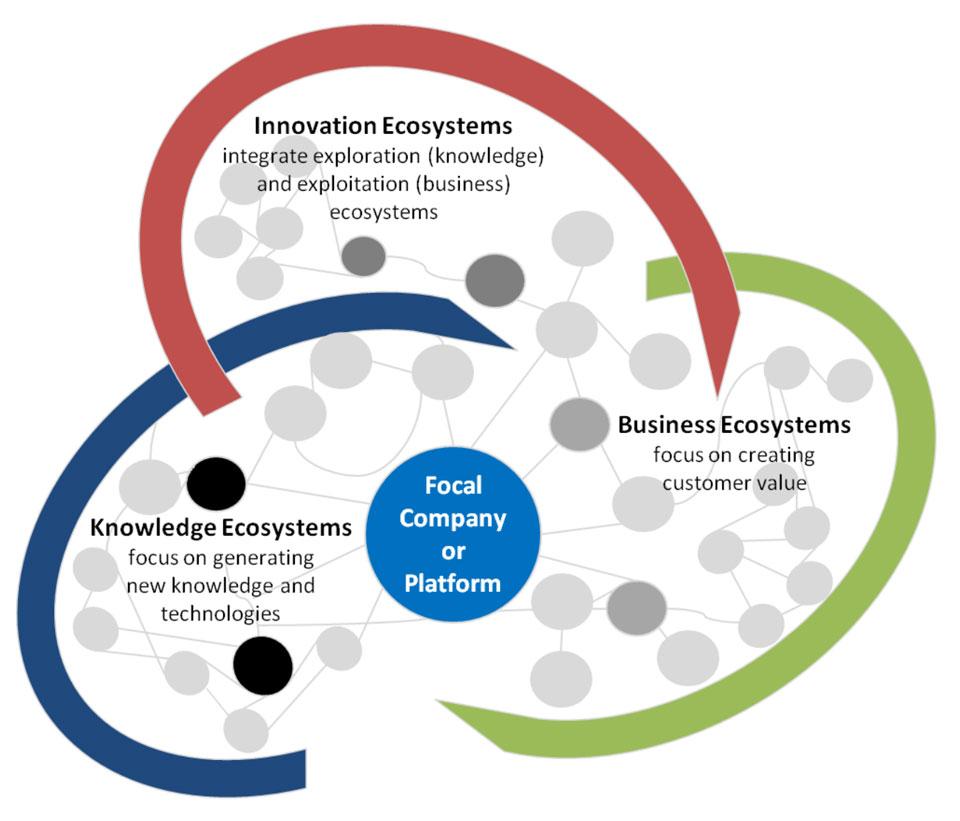
Innovation ecosystems occur as an integrating mechanism between the exploration of new knowledge and its exploitation for value co-creation in business ecosystems. Business ecosystems focus on present customer value creation, and the large companies are typical key players within them. Knowledge ecosystems have their main interest and outcome in creation of new knowledge through joint research work, collaboration, or the development of knowledge base. The focus lies on the generation of new knowledge in which research institutes and innovators, such as technology entrepreneurs, play a central role in the ecosystem. (Valkokari, 2015, p. 20)
The ecosystem types form a continuous transformation process. The ecosystem types are in an do not necessarily follow each other one-by-one but are rather in ongoing interaction and on and off emerging with each other. In connection of several knowledge ecosystems, an innovation ecosystem may emerge, that in turn can transform into several emerging and existing business ecosystems. This requires a new set of executive and management skills, a different culture, a new approach to information, as well as new forms of leadership. In many companies, this phase-change involves the transition from product-centric to service-centric organizations and the growing use of external talents in the form of social networks, open innovation platforms, design and innovation agencies. (Oksanen et al., 2018, p. 11; Shaughnessy, 2014, pp. 17–18)
Creative ecosystems can be defined as a community of connected, but disparate actors interacting within an environment and between each other. (Oksanen et al., 2018, pp. 11–12) Each of the Creve 2.0 project partners have their own bundle of competences (table 2), their specialized areas of expertise and their own business and knowledge networks which are brought into the Creve 2.0 collaboration, activities and interactions.
Table 2. Creve 2.0 project partners and their role and competences.
| Partner | Role and competences |
|---|---|
| HUMAK University of Applied Sciences | Coordinator. Development, education and networking of creative businesses, start-ups, other sectors across Finland. Regionally South-West Finland and Metropolitan area. |
| Design Center Muova/ Vaasa University of Applied Science | Market-oriented design, services and incubator models for start-ups, joint research and development platform of Vaasa UAS, Aalto University and University of Vaasa. Regionally Western Finland. |
| Österbottens hantverk r.f., NGO | Arts and Crafts Shop, non-governmental organization, hands-on workshops and education for entrepreneurs, testing and piloting new models of services, close collaboration with Muova. Regionally Western Finland. |
| Aalto University, Faculty of Engineering, Dep.of Built Environment | Digital Knowledge, digital extended services, Augmented Reality AR, VR and 3D models in creative industries, research and education. Regionally Metropolitan area. |
| University of Lapland, Faculty of Arts | Service Design, implementation on new services, research, regional features on implementation of services. Regionally Northern Finland and the Arctic. |
| Turku University of Applied Sciences, Arts Academy | Expertise of arts and creative industries, education, projects and networks of entrepreneurs. Regionally South-West Finland. |
| HAMK Häme University of Applied Sciences | Pedagogical design and development, development of educational services, digital development, eLearning, regional networks. Regionally Central Finland. |
This model enables the new level of services for all actors dealing with the creative industries. On the other hand, it forms a platform for networking inside the creative industries and across other sectors of the economy. Other significant advantages are multi-functional and cross-sectoral collaboration in service design, digital development and learning, experimental hub and educational activities, new models and pilots to be tested as well as well as the collaborative knowledge creation process itself.
Development through design
In developing new services, products or technologies it is crucial to understand the users’ needs and motivations. User research is the study of peoples’, users’ behavior, motivation and needs in a certain context, which affect how people understand and use things in their daily lives (Ratilainen et al., 2019, pp. 4–5; Marsh, 2018) According to Paasovaara (2018, presentation at Experience Design Workshop at Tampere University of Technology), the user-centered design is based on understanding the environment where product or service is used, understanding the needs of users and organizations involved, co-creation and development with the users, testing of the end-users as well as iterations and improvements.
The development is often visualized as a process where information is refined into ideas as a solution to a specific problem or a situation. The ideas are combined, processed and the best ones selected for further development and testing. (Ratilainen et al., 2019, p. 4) But organizations may have different equations to solve (Kees, 2011, pp. 522–525). If one of the elements in the equation “What + How = Result” is unknown, the situation changes. The more it changes when the Result is something abstract leading to a certain value. (Kees, 2011, pp. 522–525)
Expanding the idea further from users to the whole designing process, Kees (2011, p. 530) notices that the term Design Thinking has been sparked by organizations which have trouble dealing with open, complex problem situations. Design practices could be useful when conventional problem solving fails or when the equation (‘what’ plus ‘how’ leads to ‘value’) that an organization has been operating under somehow doesn’t work anymore. (Kees, 2011, p. 530) Design Thinking is a methodology that provides a solution-based, hands-on approach to prototyping, testing and solving problems. (Dam & Siang, 2019) Design Thinking includes two major phases: 1) identifying problems and 2) solving problems. (Figure 2.)
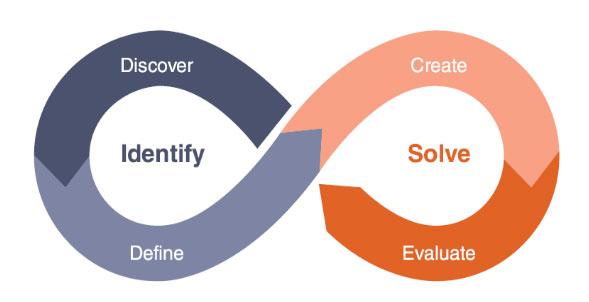
The discover mode is typically described as a process focused on gaining empathy with customers, that is, developing an understanding of their context, experiences, and behaviors. Different kind of data can be collected and synthesized; the discover mode is built on iterations between data collection and data synthesis. The define mode is characterized by the development of an expanded understanding of the users and customers, their thoughts, feelings, experiences and needs. The challenge is to identify the needs and insights most worthy of pursuit through the next phase of the process. The purpose of the create mode is to develop a concept or a prototype that can be shared with the users or target group for feedback and that, through iteration, can be improved upon. The aim of evaluation is to share prototypes with potential users and customers for feedback and to move beyond concept prototyping to full development of the product or service (Luchs, Swan, & Griffin 2015, pp. 4–8). Though the process of development through design is often non-linear, the comprehensive model of Design Thinking can be summarized in Figure 3.

The solution and the best practices are searched through iterations back and forth; by exploring things, solving problems, finding solutions, developing prototypes and by testing and retesting. (Luchs, Swan, & Griffin, 2015, pp. 8–9) The next section reveals some of the process findings and results.
Findings and Results
As the development process is still ongoing some findings and results are presented and documented here.
Iterative process of Developing
The process of development has proceeded iteratively in various phases. Some of the phases have being ongoing simultaneously. The design agency Muova has lead the planning and the implementation of iterations. The figure 4 illustrates the first phase from a vague idea to the first concept of evaluation tool.
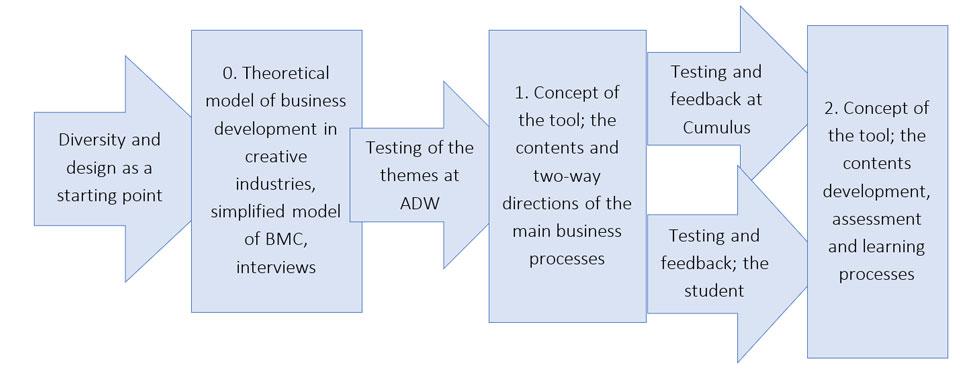
Muova Design Agency and the project group have discussed and worked on the first version during the autumn 2018. As stated in Kees (2011), when trying to solve complex and open-ended situations, the formulation of frame is essential. The development started by extensive interviews and data gathered about conditions, competences and specific features in creative industries and of creative entrepreneurs. The interviews targeted entrepreneurs, business teachers and enterprise agencies. The main findings revealed that companies are often small, they are driven by the possibility of self-expression not necessarily by growth though some polarization can be seen. Some entrepreneurs aim directly abroad and to the international market, for some entrepreneurship is more like a hobby. The need for social support is high as well as the need for understanding the future or existing opportunities in business; new customer segments, marketing and communication, production and networking and so on. It is difficult for most entrepreneurs to perceive the skills and competences they possess and therefore it is difficult to package, sell and market themselves to other industries. There are proven competence gaps in economical thinking, pricing, profitability, selling and marketing. Mentoring is seen as a good platform for peer-to-peer support and activities. (Rinne, 2019, summary of preliminary results of the interviews)
The first ideas and concept versions were also processed in pilots which were arranged in two conferences; Artic Design Week (ADW) and Cumulus Conference in Rovaniemi. ADW gathered practitioners, designers, students and researches together around “Happiness and Design”. Cumulus Conference was around the campfire of “Resilience and Intelligence”. Topics included internal and external forces, factors creating happiness in entrepreneurship, critical business areas of resilience as well as tools needed for competitive business development. The aim at the both conferences was to further develop and test various themes around entrepreneurship in creative industries and to test preliminary content areas.
The process of development has proceeded in iterations including diverse actors. Reflecting on the DT framework presented earlier, in Creve 2.0 Discover and Define modes are taking turns, data is collected and synthesized with earlier data and theories. Between the iterations the tool has been analyzed and worked further on project meetings, in the steering group, in hub meetings and workshops.
Contents of the tool
As a result of the theoretical and practical iterations the contents of the evaluation tool are at this phase formed around three content areas and three levels. Figure 5 presents the contents.
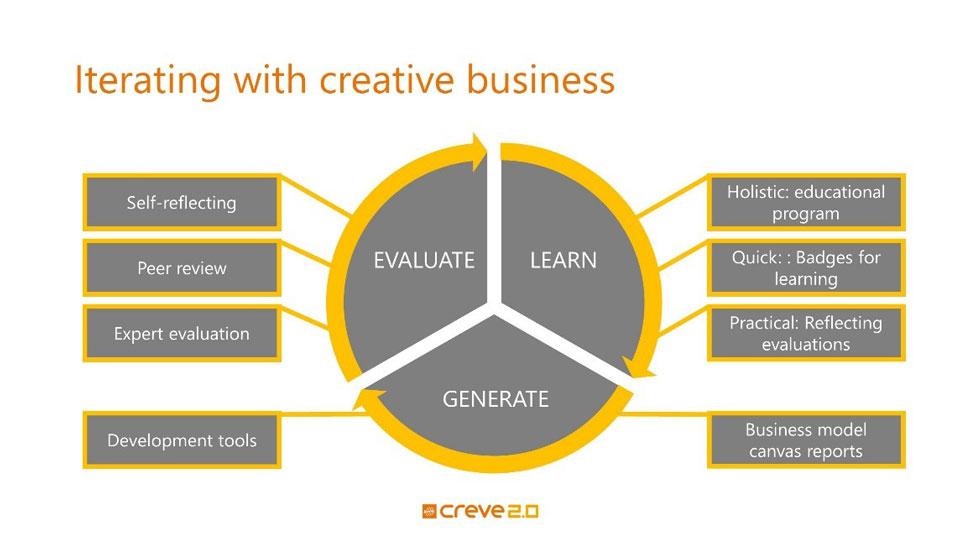
Learning and adapting are understood as key elements in developing a business idea. It means that with help of the tool an entrepreneur can study the whole program of introduction to entrepreneurship (holistic) or perform some specific contents guided by digital Open Badges (quick). At the basic level (practical) hands-on reflecting and assessing for example market forces, customer analyses, budget or cash reports are prerequisites for further phases. Generate includes the concrete results of assignments, analyses of a business plan development, and solutions that are products, services or ideas. Assignments and analyses are summarized in Business Model Canvas reports and other documents the entrepreneur is producing.
Evaluation is done on three levels. At the first level an entrepreneur is self-reflecting and assessing the planning outcomes. The second level is peer-assessment and getting feedback from other creative entrepreneurs either at the same starting point or from those already in the business. This phase allows changes and check-ups according to the feedback. It also gives mental and collegial support that according to the interviews was considered extremely important especially in small firms in creative industries (Rinne, 2019, summary of preliminary results of the interviews). The third level is the final point before starting the business. An entrepreneur has gone through the learning and development processes and has the completed business plan containing all the crucial analyses, calculations and visions. An expert (for instance financier, business advisor, investor) assessment gives the last comments and observations on the plan in order to verify the real potential of the future success.
The main element missing from this figure is an entrepreneur himself or herself. During the iterations and the interviews, it became obvious that the starting point needs to be an entrepreneur. What kind of person he/she is, what are the underlying motives, targets and visions for entrepreneurship? Most importantly, there needs to be assignments, analyses and tools helping an entrepreneur to perceive and understand the skills and competences he or she possess. As came clear in the interviews, creative people burning for their own thing are seldom able to express or visualize the core competences and skills and their value for other industries.
Now that the main elements of the tool are clear, the more detailed contents such as tools and assignments, exercises and analyses are being planned under Generate – category (market and customer, resources, economy and solutions, products, services and ideas). The one thing that raised discussion in the project team was a question on whether the aims and objectives should be separately included in the evaluation tool (Creve 2.0, Project meeting 28.5.2019). As the result of the interviews and iterations (ADW and Cumulus conference 2019) there tends to be a scale on how serious business starting entrepreneurs are driving. For some of them growth is a clear target from the beginning. For others it may be a part-time activity for self-realization. If the aim and target of the business are visible and clear for the entrepreneur, it could also help enterprise agencies, advisors and teachers to adapt the services and support in optimal proportion, in optimal time and development phase.
Conclusion
In this article we have described the first phases of co-creating and designing a development tool for business idea evaluation in creative industries. We also presented the first version of the tool and its’ content. The starting point of the development was diversity. The iterations on first phases targeted various experts (designers, researches, students, practitioners), the Creve 2.0 project team and internal meetings. The cross-scientific and cross-functional actors and participants contributed to the ideas and insights embedded in the tool.
As the result of the iterations the business idea evaluation tool is formed around three content areas and three levels; learning, generation and assessment. In the next phase the more detailed contents will be planned; tools and assignments, exercises and analyses of market and customers, resources, economy and solutions. It has become evident during the iterations that peer-assessment and feedback is in many ways crucial for entrepreneurs in creative industries in developing their business ideas. At the same time feedback from business experts and advisors is equally important especially for instance for those aiming directly to the international markets.
The future vision is clear. At the end of the iterative processes there is a web-based digital user-interface that entrepreneurs utilize when analyzing and planning their business ideas and opportunities. The process is supported by peer and advisory feedback and is guided by digital Open Badges recognizing and verifying competences and skills of the entrepreneurs in creative industries.
Authors
M.Sc. Arja Puustinen works as a lecturer in HAMK School of Professional Teacher Education / HAMK Edu Research Unit in Häme University of Applied Sciences. Her expertise includes continuous learning, adult education and competence development at work places.
M.Sc. Henry Paananen works as a lecturer in HAMK Edu Research Unit / HAMK School of Professional Teacher Education in Häme University of Applied Sciences. His expertise includes educational technology, eLearning, management, leadership and strategic planning.
M.Sc. Katja Maetoloa works as project specialist in HAMK Edu Research Unit in Häme University of Applied Sciences. Her expertise includes global education, future work skills and competence development at work places.
References
Creve 2.0. (2019). Creve 2.0 presentation. Retrieved September 26, 2019 from
https://www.creve.fi/wp-content/uploads/sites/24/2018/10/Creve2.0_Esittely-2018.pdf
Dam, B., & Siang, T. (2019). Five stages in the Design Thinking Process. Retrieved April 29, 2019 from
https://www.interaction-design.org/literature/article/5-stages-in-the-design-thinking-process
DC4WORK. (2019). Work-Based Learning in a Digital Age – Promoting Digital Competences for Better Employability and Innovation website. Retrieved March 3, 2020 from https://www.dc4work.eu/
HAMK. (2019). Future Work Research and Development. Retrieved September 26, 2019 from
https://www.hamk.fi/research/hamk-edu/future-work-research-and-development/?lang=en
Kees, D. (2011). The core of ‘design thinking’ and its application. Design Studies, 32(6), 521–532. Elsevier. https://doi.org/10.1016/j.destud.2011.07.006
Lahtinen, H., Pekkala, H., Halme, K., Salminen, V., Härmälä, V., Wiikeri, J., Lamminkoski, H., Lähde, K., Mikkelä, K., Rouvinen, P., Kotiranta, A., Pajarinen, M., Dalziel, M., Barge, B., Meade, C., & Zhao, X. (2016). Startup-yritysten kasvun ajurit ja pullonkaulat [Growth factors and bottlenecks for business start-ups]. Publications of the Government’s analysis, assessment and research activities 30/2016. http://urn.fi/URN:ISBN:978-952-287-274-6
Luchs, M., Swan S, & Griffin A. (2015). Design thinking: new product development essentials from the PDMA. John Wiley & Sons.
Maliranta, M., Pajarinen, M., & Rouvinen, P. (Eds.) (2018). Startupit kansantaloudessa [Startups in national economy]. Helsinki: Taloustieto Oy (ETLA B277). Retrieved August 30, 2019 from https://pub.etla.fi/ETLA-B277.pdf
Marsh, S. (2018). User Research: A Practical Guide to Designing Better Products and Services. London: Kogan Page.
Ministry of Economic Affairs and Employment of Finland. (n.d). Intangible value in business operation. Retrieved September 26, 2019 from
https://tem.fi/en/intangible-value-creation
Ministry of Education and Culture. (2017). Luova talous ja aineettoman arvon luominen kasvun kärjiksi. Luovat alat Suomen talouden ja työllisyyden vahvistajina -työryhmän raportti [Promoting the creative economy and intangible value creation as spearheading growth sectors. Report of the working group on recognising the creative sectors as a driver of Finnish economy and employment]. Publications of the Ministry of Education and Culture, Finland 2017:18. http://urn.fi/URN:ISBN:978-952-263-464-1
Oksanen, J. (2018). CreaEco -hanke – Suomen luovan talouden ekosysteemien tila ja kehittämistarpeet [CreaEco project – the ecosystemic state and development needs of the creative economy in Finland]. [Presentation material]. Retrieved June 2, 2019 from https://minedu.fi/documents/1410845/7965204/Oksanen+Juha.pdf/5976937a-b28b-4401-bb31-3e9efc04b3da/Oksanen+Juha.pdf.pdf
Oksanen, J., Kuusisto, O., Lima-Toivanen, M., Mäntylä, M., Naumanen, M., Rilla, N., Sachinopoulou, A., & Valkokari K. (2018). In search of Finnish creative economy ecosystems and their development needs – study based on international benchmarking. Publication series of the Government´s analysis, assessment and research activities 50/2018. http://urn.fi/URN:ISBN:978-952-287-599-0
Ratilainen, J., Paananen, H., Puustinen, A., Lammi, M., & Hautala, V. (2019) Luovien alojen liikeideoiden arviointityökalu [Evaluation tool for business ideas in creative fields]. In T. Römer-Paakkanen, M. Suonpää , & A. Hermiö (Eds.), YRITTÄJYYSKASVATUKSEN KAARI, Lapsuudesta tulevaisuuden työhön. THE TRAIL OF ENTREPRENEURSHIP EDUCATION. From Childhood to Future Work and Entrepreneurship (pp. 149–171). http://urn.fi/URN:NBN:fi-fe202002125198
Shaughnessy, H. (2014). Recognizing the ecosystem phase-change: a guide to four types. Strategy & Leadership, 42(1), 17–23. https://doi.org/10.1108/SL-09-2013-0074
Tarjanne, P., Jokinen, J., Ylätalo, R., Lamberg, I., Möller, M., & Toiskallio, M. (Ed.) (2011). Sirpalepolitiikasta kohti luovan talouden ekosysteemiä – Loppuraportti työ- ja elinkeinoministeriön Luovan talouden strategisesta hankkeesta 2008–2011 [From fragment politics towards an ecosystem of creative economy – Final report of the strategic project on Creative economy by the Ministry of Employment and the Economy 2008–2011]. Publications of the Ministry of Employment and the Economy, Concern 35/2011. https://tem.fi/documents/1410877/3346190/Sirpalepolitiikasta+kohti+luovan+talouden+ekosysteemi%C3%A4+28092011.pdf
Valkokari, K. (2015). Business, Innovation, and Knowledge Ecosystems: How They Differ and How to Survive and Thrive within Them. Technology Innovation Management Review 5(8), 18–24. http://doi.org/10.22215/timreview/919





